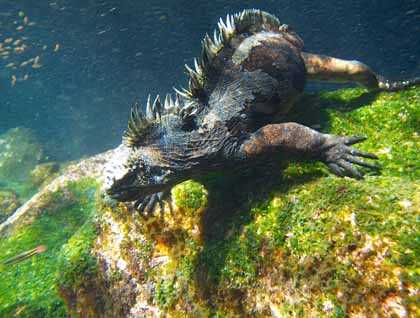Our day starts with a bright sky and an eager energy in the air. North Seymour was once a subaquatic area connected to Santa Cruz Island and through volcanic uplifts it has arrived to where we are landing today. Naturally dry due to its position in the rain-shadow of Santa Cruz, North Seymour does not appear to be lively, however we find an abundance of life as we explore inland. Land iguanas lumber about as they search for their daily nutrition among the prickly pear cacti. As we head inland after landing we notice that this island is quite alive. Magnificent and great frigate birds use this island as a nesting area and we come upon various chicks in different sizes as they sit upon the nests awaiting their parents’ return so they may obtain nutrition. Grey incense trees surround the path as we make our way inland. An occasional croton tree and palo verde trees add color to the surroundings as we balance ourselves over the boulder terrain. It is hard to believe that life can sustain itself in this arid environment, however we continue to find the lively struggle for existence. As we return to the coastal area a few blue-footed boobies display in the distance, trying to find mates as male frigate birds and their inflated gular sacs try to obtain theirs. Along the coast, Galapagos sea lions are present with many young pups playing in the intertidal zone awaiting their mothers’ to return from foraging so they may feed. As we walk among skeletal remains we are reminded of this continual struggle for life.
The afternoon and a short navigation brings us to Rabida Island. Incense trees dot the terrain on a bright red volcanic background and some are surprised at the drastic change from our morning visit. Exploration of the undersea world ensues with snorkeling from the beach and the Zodiacs along the coast. The occasional pacific green sea turtle pops its head up as they take a breath of fresh air enter into the calm water. The occasional school of fish passes as we start to concentrate on the details of this otherworldly realm and we notice a marine iguana feeding on algae a couple of meters underwater. A white-tipped reef shark gracefully swims past with razor surgeonfish grazing upon the shallow reef. As we concentrate more we notice small blennies poking their heads out of abandoned barnacles awaiting food to pass by. Brightly colored sea anemones and panamic sea stars add color as a Galapagos sea lion swims past, considering if we are worth the time to play with. In the late afternoon we eventually land on Rabida and have a chance to hike and explore the coastal area. As the sun dips into the distant horizon, the light paints an interesting picture upon the sea lions that are lazing on the beach. A flycatcher flits among our group and Galapagos mocking birds fight over territory. Small mollusk shells are found underfoot and as the light of this day dissipates we are rewarded some insight into this continuous struggle for existence for life with us being a prime witness.









